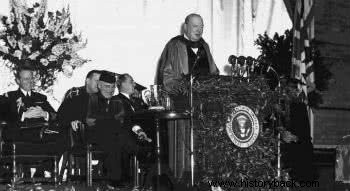The expression iron curtain was created by British politician Winston Churchill. He first used it during a speech he gave in Fullton, Missouri, in 1946.
With this term, the former British minister warned that Stalin's government would continue to influence the territories he had liberated during World War II and would isolate them from Western Europe.
The expression "Iron Curtain" would be used during the Cold War period to characterize the world divided into capitalist and socialist countries.
Churchill's Speech

Churchill delivers his famous speech.
At first, the speech was not well received because Stalin had been the great US ally in defeating the Nazis. But Churchill knew the Russians well and knew that Stalin would do his best to extend communism beyond their borders.
In this way, capitalist countries should stop Soviet influence through economic and military aid to European countries not occupied by the Soviets.
One of the clearest examples was Greece. When the civil war broke out in Greece, for geopolitical reasons the British intervened militarily and defeated the supporters of communism in that country.
Thus, the Americans set in motion the Marshall Plan in order to capture the European countries to capitalism. On the other hand, they created NATO in 1949 to ensure a military alliance between these same countries.
The USSR would respond with the Warsaw Pact, 1955, increasing military tension in the Cold War.
Learn more about the Cold War and Eastern Europe.
Iron Curtain and the Berlin Wall
However, it was becoming clear to the US that Eastern European countries were moving into Soviet influence and adopting communism as a form of government regime.
What worried the United States most was the occupation of Germany, the largest and most industrialized of the European countries. Germany had been liberated and occupied by the Soviet Union and the Allies and was therefore an area of friction between these two powers.
In this way, the solution found was the division of Germany into four occupation zones that would guarantee zones of influence to the United States, England, France and the Soviet Union.
Then, the country found itself divided between West Germany, of American influence, whose capital was Bonn; and East Germany, supported by the USSR, where the capital was Berlin.
The wall, built in 1961, symbolized the division of the world between communists and capitalists, and was one of the points of tension in the Cold War.
See also:Consequences of World War IICountries of the Iron Curtain
- Russia
- Armenia
- Azerbajan
- Belarus
- Estonia
- Georgia
- Kazakhstan
- Lithuania
- Latvia
- Moldova
- Ukraine
- East Germany
- Poland
- Czechoslovakia
- Hungary
- Bulgaria
- Romania
Learn more about the life of Winston Churchill.
